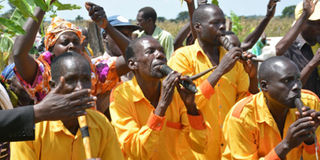Awakening Lango’s tourism

A cultural troupe performs in Lira recently. Cultural dances are some of the tourist attaction in Lango sub-region. Courtesy photo
When you speak about Lango sub-region, rarely does the thought of its tourism potential come to mind. Although the sub-region has a rich tourism potential, not much is known and not many Ugandans have had the opportunity to visit its districts of Alebtong, Amolatar, Apac, Dokolo, Kole, Lira, Oyam and Otuke.
The sub-region’s population stands at 2.1 million, according to National Housing and Population Census report 2014.
Last month, Lango was the centre of the Tulambule campaign, a domestic tourism initiative aimed at making Ugandans aware of the country’s tourism potential.
A team of tourism officials, led by the State minister of Tourism, Godfrey Kiwanda, toured a number of sites, held tourism education engagements with schools, had a community hike on Got Ngeta, visited various attractions in the three-day excursion that concluded last Sunday.
The campaign is set to carry out site visits, product identification, mapping, branding and promotion, culture, heritage and development of historical spots.
“Lango sub-region has unique, rich history and culture that they exhibit. Their culinary dishes are amazing. Their dance is captivating and infectious. We are here to publicly declare that the sub-region is open and ready for tourism,” Steven Asiimwe, CEO Uganda Tourism Board, said.
Residents and officials in Lango recognise this potential, however, they decry the fact that the sub-region has not been developed.
John Baptist Okello-Okello, former Dokolo District chairperson, pointed out that Lango’s resources are not being developed and promoted, highlighting the challenge of proper packaging and marketing.
“We have numerous sites, for example Ibuje Hill in Apac District which is very beautiful, we have birds, rice growing, Ngetta rock, Akokoro Sub-county in Apac, Dr Milton Obote’s home, traditional dances, monument built at St Mary’s Aboke Girls, Iceme where Opendo Art and Craft is,” he said.
According to Alex Oremo Alot, Lira District chairperson, more than 700 tourists have visited Lira this year.
Samuel Ojok, 75, a resident of Adekokowok Sub-county in Lira, says leaders were given the responsibility for tourism development but they are a disappointment because they do not know their role in wider perspectives.
Unity to build capacity of the players in the area is seen as solution to improve its tourism potential.
Lira municipality MP Jimmy Akena said tourism will only be developed and promoted in Lango sub-region if all the district leaders work together to highlight what Lango is.
Infrastructural development will also help to ease transportation in the sub-region, according to Joy Atim Ongom, Lira Woman MP. “If government tarmacs Apac to Lira roads, Lango sub-region will become a centre of tourism,” she said.
The sites
• Barlonyo Memorial Site where 302 innocent civilians were killed by the Lord’s Resistance Army Rebels (LRA) in February 2004.
•Amolatar landing site
•Kangai area, Dokolo District in where Omukama Kabalega of Bunyoro and Ssekabaka Mwanga sought refuge from the British colonialists
•Otuke hill
•Shea butter (mwoya) making
•Cultural heritage
•Olwney Swamp




